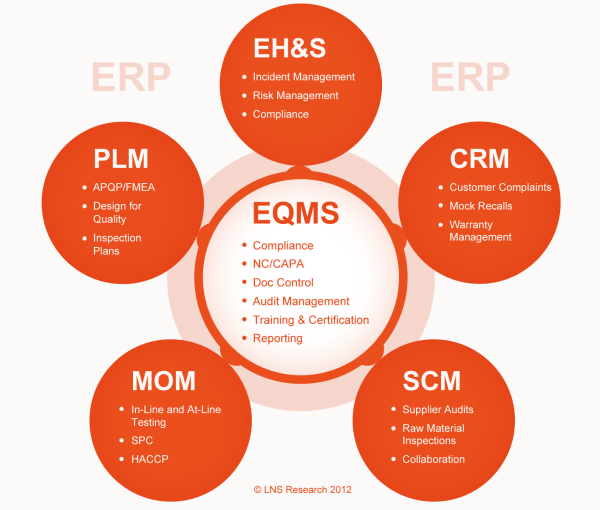In our most recent blog post, we discussed many of the gaps that exist in companies' IT architectures regarding collaboration, compliance, and EQMS. We highlighted recent benchmark data focused on the life sciences industry but the trend holds across all industries. Adoption rates of EQMS or Enterprise Quality Management Software remains low (20%-30% for most industries) while point solutions around Corrective and Preventive Actions (CAPA), Document Control, Compliance Management, and more remain high (50%+).
The consequence of this approach means many manufacturing companies today cannot effectively share data, orchestrate business processes, or collaborate with internal and external stakeholders. To address this situation, LNS Research generally recommends companies invest in closed-loop quality management, which involves EQMS as the hub that connects multiple enterprise software systems from a quality perspective. By aligning the right mix of people, processes, and technology capabilities, companies can flow quality data through the value chain from customers all the way to engineering.
Enterprise Quality Management Software Architecture

There are, however, many different options when it comes to EQMS vendors. To help companies understand the market, we have been working diligently over the past 6 months to publish our new solution selection guide for EQMS. We will also be sharing many of the results of this report in an upcoming webcast to be announced soon. However, when it comes to Quality Management Software and collaboration, there's one company that does not come to mind as often as it should: Microsoft.
Microsoft plays in the EQMS market in 3 main ways
- As a .net ISV partner: Many of the most widely adopted EQMS vendors have been longtime Microsoft partners and have either built original systems (or in some cases re-architected cloud-based systems) on the Microsoft stack.
- As a SharePoint ISV partner: A smaller subset of EQMS vendors (NextDocs and QUMAS to name a few) have chosen to develop an even deeper partnership with Microsoft and develop software on the SharePoint platform.
- As an end-user development platform: Microsoft's preferred engagement model is as a platform for ISVs, but there are always companies and CIOs that prefer to build and develop homegrown systems. For these companies, SharepPoint, along with the complete Microsoft technology stake, remain a compelling offering for quality, compliance, and collaboration.
Microsoft SharePoint is a particularly compelling platform for both EQMS vendors as well as end-users developing home grown systems for a number of reasons. For ISVs, there are three obvious reasons to partner with Microsoft among many: a large installed base, a strong set of marketing resources to support efforts, and the right built-in functionality on top of a proven and scalable platform.
For end-users choosing to build on top of Microsoft SharePoint, the choice is more likely driven by two factors: an established enterprise commitment to Microsoft technology and the right scalability and functionality in the platform. This, of course, begs the question: what is the Microsoft SharePoint functionality that makes it a strong option for EQMS, Collaboration, and Compliance?
A few answers that LNS Research thinks are important are as follows:
- Audit Trails and Single Sign On
- Enterprise Content Management
- Workflow Automation and Business Intelligence
- Communities and Wikis
- Composite Application Development
- Mobility
- Search
- Cloud Enabled
If the areas discussed in this post are of interest to you and you'd like to learn more, on September 20, 2012, our President and Principal Analyst, Matthew Littlefield, is speaking on this topic at a seminar held by QUMAS in Princeton, NJ. He will discuss how quality management software can benefit organizations, specifically in the areas of compliance and collaboration.
You may also be interested in:
Quality Management System: 5 Must Have Features for EQMS
Overall Equipment Effectiveness: Benchmark Data by Industry
Top 3 Strategies for Selecting an EQMS Solution
Collaboration and EQMS: The Missing Link in Life Sciences

